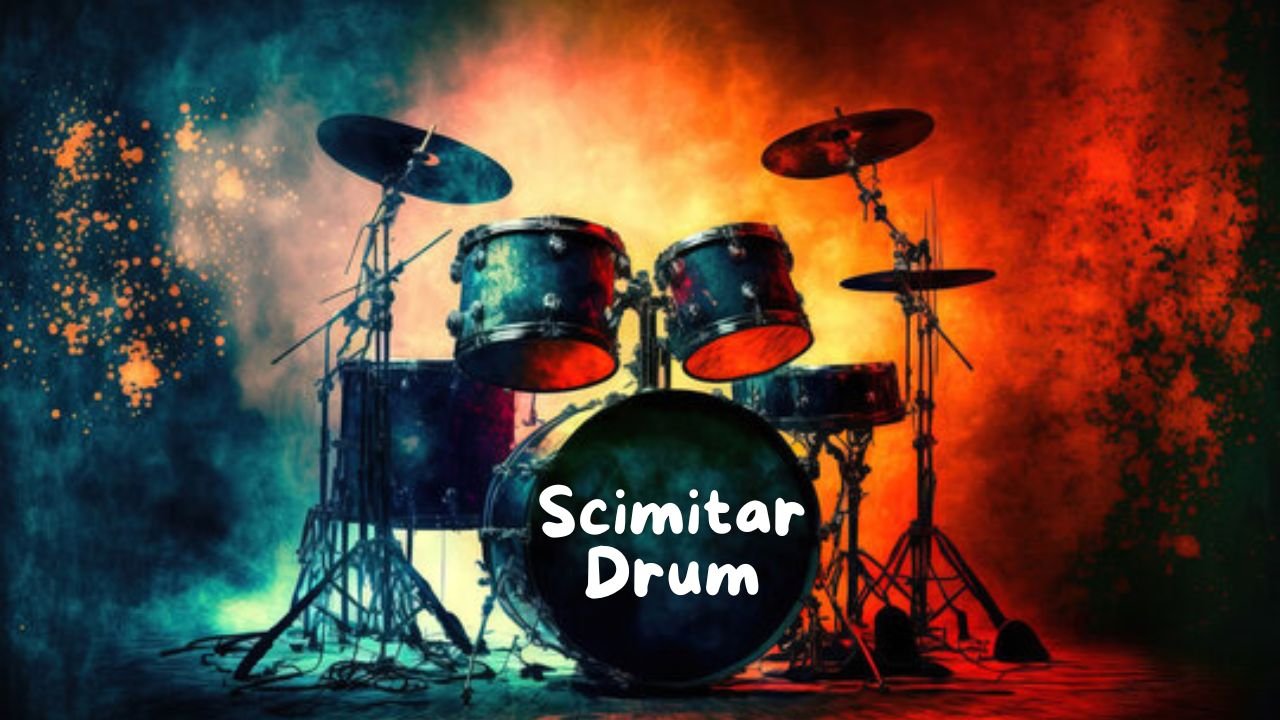Have you ever heard the captivating rhythms of a scimitar drum? Its unique sound and rich history make it a fascinating instrument to explore. Whether you’re a music enthusiast, a percussionist, or someone interested in cultural traditions, mastering the beat of the scimitar drum can be a rewarding experience.
In this blog post, we’ll take you on a journey through the world of scimitar drums. You’ll learn about its historical significance, unique design, and the various techniques used to play it. We’ll also provide tips on maintenance, care, and what to look for when buying your first scimitar drum. By the end of this guide, you’ll have a thorough understanding of this remarkable instrument and be ready to start your own musical adventure.
What is a Scimitar Drum?
Definition and Description
The scimitar drum is a distinctive percussion instrument known for its curved shape, which resembles a scimitar sword. This unique design sets it apart from other drums and contributes to its special acoustic properties. Typically, scimitar drums are hand-held and played with fingers, palms, or mallets, producing a wide range of sounds.
Historical Background and Origin
The origins of the scimitar drum can be traced back to ancient civilizations. It has been prominently featured in Middle Eastern, Central Asian, and North African cultures for centuries. Historical records and artifacts suggest that early versions of the scimitar drum were used in various ceremonial and celebratory contexts. Over time, it evolved and spread to different regions, influenced by local traditions and innovations.
Historical Significance
Cultural Importance
The scimitar drum holds significant cultural value in many societies. It is often associated with traditional music, dance, and rituals. In some cultures, the drum is believed to have spiritual and healing properties, making it an essential component of religious ceremonies and folk traditions.
Role in Different Cultures and Traditions
Throughout history, the scimitar drum has played a vital role in various cultural practices. In Middle Eastern music, it is commonly used in belly dancing and folk music ensembles. In North Africa, it accompanies traditional Gnawa music, contributing to the rhythmic foundation of performances. The drum’s versatility and adaptability have allowed it to be integrated into diverse musical genres and cultural expressions.
Symbolism and Meanings
Beyond its musical function, the scimitar drum carries symbolic meanings. Its curved shape represents the crescent moon, a symbol of growth and renewal in many cultures. The drum’s resonant sound is often associated with communication and expression, serving as a medium to convey emotions and tell stories. In some traditions, the drum is considered a bridge between the physical and spiritual realms, connecting performers with their heritage and identity.
Design and Construction
Unique Features
The scimitar drum’s design features distinct elements that contribute to its unique sound and appearance. Its curved body is typically made from wood or metal, providing a sturdy structure. The drumhead, often crafted from animal skin or synthetic materials, is stretched tightly over the frame to create a resonant surface.
Shape and Materials
The shape of the scimitar drum is its most defining characteristic. The curve of the drum body enhances its acoustic properties, allowing for a wide range of tones and pitches. Traditional scimitar drums are made from materials such as wood, clay, or brass, each offering a different timbre. Modern variations may incorporate synthetic materials for durability and consistency.
Comparison with Other Types of Drums
Compared to other drums, the scimitar drum stands out due to its unique shape and playing style. Unlike cylindrical drums like the djembe or conga, the scimitar drum’s curved design allows for a different distribution of sound waves. This results in a distinct tonal quality that is both rich and versatile. Additionally, the playing techniques used for the scimitar drum differ from those of other percussion instruments, offering a unique rhythmic experience.
Craftsmanship
Traditional Methods
Crafting a scimitar drum involves intricate techniques passed down through generations. Skilled artisans use traditional methods to shape the drum’s body, ensuring precise curvature and structural integrity. The drumhead is carefully selected and treated to achieve the desired sound quality. Each step in the crafting process requires meticulous attention to detail, resulting in a finely crafted instrument.
Modern Innovations
While traditional craftsmanship remains highly valued, modern innovations have also influenced the production of scimitar drums. Advances in materials and manufacturing techniques have led to the development of more durable and consistent instruments. Synthetic drumheads, for example, provide greater longevity and stability in varying environmental conditions. Additionally, contemporary designs may incorporate ergonomic features to enhance playing comfort.
Sound and Music
Acoustic Properties
The scimitar drum’s unique shape significantly impacts its acoustic properties. The curved body allows for a diverse range of tones, from deep bass to sharp treble. When struck, the drumhead vibrates, producing sound waves that resonate within the curved frame. This creates a rich and dynamic sound that can be tailored to different musical styles.
Types of Music and Rhythms
The versatility of the scimitar drum makes it suitable for various musical genres. In traditional Middle Eastern music, it often provides the rhythmic foundation for dance and folk melodies. In contemporary settings, it can be used in fusion genres, blending with other instruments to create innovative sounds. Common rhythms played on the scimitar drum include intricate patterns such as maqsum, saidi, and baladi, each contributing to the overall musical texture.
Famous Performances and Artists
The scimitar drum has been featured in numerous notable performances and by esteemed artists worldwide. Renowned percussionists like Hossam Ramzy and Karim Nagi have showcased the drum’s versatility in their performances, captivating audiences with its mesmerizing rhythms. Additionally, the scimitar drum has been used in various world music ensembles, contributing to the global appreciation of this unique instrument.
Playing Techniques
Basic Techniques
Playing the scimitar drum involves mastering fundamental techniques. Start by holding the drum comfortably in your lap or against your body. Use your fingers and palms to strike the drumhead, experimenting with different pressures and angles to produce various tones. Basic rhythms, such as the dum, tek, and slap, form the foundation of scimitar drum playing.
Common Rhythms and Patterns
Once you’ve grasped the basic techniques, you can explore common rhythms and patterns. The maqsum rhythm, characterized by a steady beat with accents, is widely used in Middle Eastern music. The saidi rhythm adds a lively and energetic feel to performances, while the baladi rhythm offers a more traditional and earthy quality. Practicing these patterns will help you develop a strong sense of rhythm and timing.
Advanced Techniques
For more experienced players, advanced techniques can elevate your scimitar drum skills. Experiment with finger rolls, where you rapidly strike the drumhead with your fingers to create a rolling sound. Incorporate ghost notes, soft and subtle strokes that add complexity to your rhythms. Additionally, explore different hand positions and combinations to achieve intricate and dynamic patterns.
Maintenance and Care
Proper Care
To ensure the longevity of your scimitar drum, proper care is essential. Regularly clean the drumhead with a soft cloth to remove dust and debris. Avoid exposing the drum to extreme temperatures or humidity, as these conditions can affect its performance. When not in use, store the drum in a protective case to prevent damage.
Repair and Maintenance Tips
Over time, your scimitar drum may require minor repairs and maintenance. If the drumhead becomes loose or damaged, it can be re-tuned or replaced. Check the frame for any cracks or signs of wear, and address them promptly to maintain the drum’s integrity. Regularly inspect the drum’s hardware, ensuring that all components are secure and functional.
Buying Guide
What to Look For
When purchasing a scimitar drum, several key features should be considered. First, assess the quality of craftsmanship, ensuring that the drum is well-constructed and durable. Pay attention to the materials used, as they significantly impact the drum’s sound and longevity. Additionally, consider the drum’s size and weight, ensuring it is comfortable to play and transport.
Recommended Brands and Models
Several reputable brands offer high-quality scimitar drums. Brands like Remo, Meinl, and LP Percussion are known for their craftsmanship and reliable performance. When choosing a model, consider your skill level and musical preferences. Entry-level drums are great for beginners, while professional models offer advanced features for experienced players.
You May Also Like: Chillwithkira Ticket Show: Ultimate Entertainment Awaits!
Conclusion
The scimitar drum is a remarkable instrument with a rich history and unique sound. Its cultural significance, distinctive design, and versatile playing techniques make it a valuable addition to any musician’s repertoire. By understanding its origins, mastering basic and advanced techniques, and properly maintaining the drum, you can fully appreciate its beauty and contribute to the preservation of this ancient art form.
FAQs
What is the origin of the scimitar drum?
The scimitar drum originated in ancient civilizations and has been prominently featured in Middle Eastern, Central Asian, and North African cultures for centuries.
What materials are used to make a scimitar drum?
Traditional scimitar drums are made from materials such as wood, clay, or brass, while modern variations may incorporate synthetic materials for durability.
What are some common rhythms played on the scimitar drum?
Common rhythms include maqsum, saidi, and baladi, each contributing to the overall musical texture of performances.
How should I care for my scimitar drum?
Regularly clean the drumhead, avoid extreme temperatures and humidity, and store the drum in a protective case when not in use.
What should I consider when buying a scimitar drum?
Assess the quality of craftsmanship, materials used, size, and weight of the drum, and choose a reputable brand suitable for your skill level and musical preferences.











